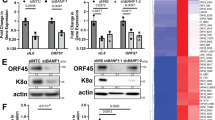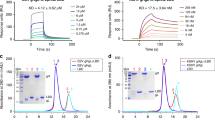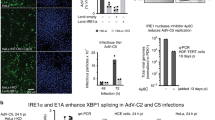Abstract
During papillomavirus infection, the E5 protein localizes in the cell Golgi apparatus and other endomembrane compartments. Cells transformed by E5 do not express major histocompatibility class I complex (MHC I) on the cell surface, while cells transformed by the other transforming proteins E6 and E7 do. In addition, the total amount of both MHC I protein and mRNA is reduced in E5-transformed cells. Here we show that expression of bovine papillomavirus E5 causes the retention of MHC I in the Golgi apparatus, thus preventing its transport to the cell surface. We ascribe this effect to a failure of acidification of the Golgi apparatus, as similar effects are observed in control cells treated with the ionophore monensin. Treatment of E5-transformed cells with either β- or γ-interferon increases the synthesis of MHC I, showing that inhibition of MHC I expression by E5 is not irreversible. However, even after interferon treatment, MHC I, although increased in quantity, is not transported to the cell surface. E5 therefore affects MHC I at several levels, but prevention of MHC I transport to the cell surface appears to be the dominant effect. Lack of surface MHC I would have profound consequences for presentation of viral peptides to the immune system.
This is a preview of subscription content, access via your institution
Access options
Subscribe to this journal
Receive 50 print issues and online access
$259.00 per year
only $5.18 per issue
Buy this article
- Purchase on Springer Link
- Instant access to full article PDF
Prices may be subject to local taxes which are calculated during checkout





Similar content being viewed by others
References
Agrawal S, Kishore MC . 2000 J. Hematother. Stem Cell Res. 9: 795–812
Anderson RA, Scobie L, O'Neil BW, Grindlay GJ, Campo MS . 1997 Vet. J. 154: 69–78
Anderson RG, Pathak RK . 1985 Cell 40: 635–643
Ashby ADM, Meagher L, Campo MS, Finbow ME . 2001 J. Gen. Virol. 82: 2353–2362
Ashrafi GH . 1998 Mutational analysis of the transforming protein E8 (E5) of bovine papillomavirus Type 4 PhD Thesis. Glasgow University, UK
Ashrafi GH, Pitts JD, Faccini A, McLean P, O'Brien V, Finbow ME, Campo MS . 2000 J. Gen. Virol. 81: 689–694
Ashrafi GH, Tsirimonaki E, Marchetti B, O'Brien PM, Sibbet GJ, Andrew L, Campo MS . 2002 Oncogene 21: 248–259
Barr FA, Nakamura N, Warren G . 1998 EMBO J. 17: 3258–3268
Bachert C, Lee TH, Linstedt AD . 2001 Mol. Biol. Cell 12: 3152–3160
Bensaid A, Kaushal A, Machugh ND, Shapiro SZ, Teale AJ . 1989 Anim. Genet. 20: 241–255
Boss WF, Morre' DJ, Mollenhauer HH . 1984 Eur. J. Cell Biol. 34: 1–8
Briggs MW, Adam JL, McCance DJ . 2001 Virology 280: 169–175
Burkhardt A, Willingham M, Gay C, Jeang KT, Schlegel R . 1989 Virology 170: 334–339
Burnett S, Jareborg N, DiMaio D . 1992 Proc. Natl. Acad. Sci. USA 89: 5665–5669
Chang JL, Tsao YP, Liu DW, Huang SJ, Lee WH, Chen SL . 2001 J. Biomed. Sci. 8: 206–213
Chikuma T, Inomata Y, Tsuchida K, Hojo H, Kato T . 2002 Neurosci. Lett. 326: 89–92
Conrad M, Bubb VJ, Schlegel R . 1993 J. Virol. 67: 6170–6178
DiMaio D, Mattoon D . 2001 Oncogene 20: 7866–7873
Faccini AM, Cairney M, Ashrafi GH, Finbow ME, Campo MS, Pitts JD . 1996 J. Virol. 70: 9041–9045
Finbow ME, Harrison M, Jones P . 1995 Bioessays 17: 247–255
Franchini G, Mulloy JC, Koralnik IJ, Lo Monico A, Sparkowski JJ, Andresson T, Goldstein DJ, Schlegel R . 1993 J. Virol. 67: 7701–7704
Frazer JH, Tindle RW . 1996 Papillomavirus Reviews Lacey C (ed) Leeds, UK: Leeds University Press pp. 151–164
Goldstein DJ, Finbow ME, Andresson T, McLean P, Smith K, Bubb V, Schlegel R . 1991 Nature 352: 347–349
Graham SP, Jones GE, MacLean M, Livingstone M, Entrican G . 1995 J. Comp. Pathol. 112: 185–195
Halaban R, Patton RS, Cheng E, Svedine S, Trombetta ES, Wahl ML, Ariyan S, Hebert DN . 2002 J. Biol. Chem. 277: 14821–14828
Ham J, Dostatni N, Gauthier JM, Yaniv M . 1991 Trends Biochem. Sci. 16: 440–444
Jackson ME, Pennie WD, McCaffery RE, Smith KT, Grindlay GJ, Campo MS . 1991 Mol. Carcinog. 4: 382–387
Johnson JM, Nicot C, Fullen J, Ciminale V, Casareto L, Mulloy JC, Jacobson S, Franchini G . 2001 J. Virol. 75: 6086–6094
Mantovani F, Banks L . 2001 Oncogene 20: 7874–7887
Morgan IM, Campo MS . 2000 Papillomavirus Report 11: 127–132
Munger K, Basile JR, Duensing S, Eichten A, Gonzalez SL, Grace M, Zacny VL . 2001 Oncogene 20: 7888–7898
O'Brien PM, Campo MS . 2002 Virus Res. Virus escape from immunosurveillance Campo MS (ed) Shannon, Ireland: Elsevier Science
O'Brien V, Ashrafi GH, Grindlay GJ, Anderson R, Campo MS . 1999 Virology. 255: 385–394
Oelze I, Kartenbeck J, Crusius K, Alonso A . 1995 J. Virol. 69: 4489–4494
Pennie WD, Grindlay GJ, Cairney M, Campo MS . 1993 Virology 193: 614–620
Raposo G, Martien van Santen H, Leijendekker R, Geuze HJ, Ploegh HL . 1995 J. Cell Biol. 131: 1403–1419
Schapiro F, Sparkowski J, Adduci A, Suprynowicz F, Schlegel R, Grinstein S . 2000 J. Cell Biol. 148: 305–315
Schoonderwoert VT, Jansen EJ, Martens GJ . 2002 Eur. J. Biochem. 269: 1844–1853
Skinner MA, Wildeman AG . 2001 J. Biol. Chem. 276: 48451–48457
Straight SW, Herman B, McCance DJ . 1995 J. Virol. 69: 3185–3192
Surti T, Klein O, Aschheim K, DiMaio D, Smith SO . 1998 Proteins 33: 601–612
Tartakoff AM . 1983 Cell 32: 1026–1028
Thomsen P, van Deurs B, Norrild B, Kayser L . 2000 Oncogene 19: 6023–6032
Tindle RW . 2002 Nat. Rev. Cancer 2: 59–65
Toye PG, MacHugh ND, Bensaid AM, Alberti S, Teale AJ, Morrison WI . 1990 Immunology 70: 20–26
Yewdell JW, Bennink JR . 1999 Ann. Rev. Cell Dev. Biol. 15: 579–606
Zhang GF, Driouich A, Staehelin LA . 1993 J. Cell Sci. 104: 819–831
Zhang GF, Driouich A, Staehelin LA . 1996 Eur. J. Cell Biol. 71: 332–340
Acknowledgements
We thank Dr Robina Ullah for her measurements of MHC I heavy chain and E5 mRNA in IFN-treated cells. We are indebted to Drs Shirley Ellis, Gary Entrican, Liz Glass, Martin Lowe, Stuart Ford and Simon Powis for their kind gifts of reagents. We thank Dr Simon Powis for his critical reading of the manuscript. This work was supported by the Medical Research Council, the Association for International Cancer Research and Cancer Research UK (formerly Cancer Research Campaign). MS Campo is a Fellow of Cancer Research UK.
Author information
Authors and Affiliations
Corresponding author
Rights and permissions
About this article
Cite this article
Marchetti, B., Ashrafi, G., Tsirimonaki, E. et al. The bovine papillomavirus oncoprotein E5 retains MHC class I molecules in the Golgi apparatus and prevents their transport to the cell surface. Oncogene 21, 7808–7816 (2002). https://doi.org/10.1038/sj.onc.1205885
Received:
Revised:
Accepted:
Published:
Issue Date:
DOI: https://doi.org/10.1038/sj.onc.1205885
Keywords
This article is cited by
-
Molecular Docking Analysis of 120 Potential HPV Therapeutic Epitopes Using a New Analytical Method
International Journal of Peptide Research and Therapeutics (2020)
-
Papillomavirus DNA not detected in canine lobular orbital adenoma and normal conjunctival tissue
BMC Veterinary Research (2019)
-
hrHPV E5 oncoprotein: immune evasion and related immunotherapies
Journal of Experimental & Clinical Cancer Research (2017)
-
Inhibition of MHC‐I by Brucella abortus is an early event during infection and involves EGFR pathway
Immunology & Cell Biology (2017)
-
Papillomavirus E5: the smallest oncoprotein with many functions
Molecular Cancer (2011)



